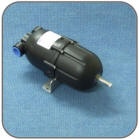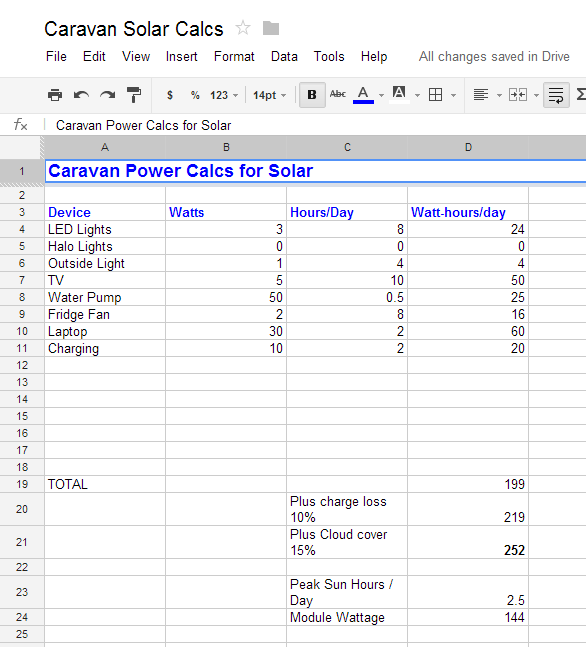How much power do I need?
Electric current is measured in Amps (or more correctly Amperes) and capacity is measured in the number of Amps per Hour; or Ah. Watts is also used to measure electrical current and is Amps x Volts.
To determine how much power you require simply add up how much current each of your electrical devices use over the time they are used for. On top of that you must then factor in how much your battery(s) will self-discharge and any inefficiency losses.
As you can see, I've listed all my electrical devices, plugged in their Watts and how many hours I use them each day. This is then multiplied, in the last column, to get the number of Watt-hours/Day.
After adding them to a TOTAL (Line 19), I then add on a loss/inefficiency factor and a 15% Cloud Cover factor. This brings the TOTAL Requirement, on Line 21, up to 252 Watt-hours/day.
When listing your electrical devices, pay particular attention to high consumption and high usage devices:
- LED Lights: Subjectively, I have found them to be about half the wattage of halogen lighting of similar lighting intensity.
- TV: You need to actually look at the back of your TV or its adaptor plug, to get an estimate of its wattage. This is VERY IMPORTANT because for most caravans it will be the highest consumer of power. It will likely also vary the greatest between caravans as screen size (and viewing hours) makes a big difference. A 16" screen (pretty normal) will draw 4 times the power of an 8" screen (adequate but on the small side).
 Water Pump: If you have a water pump, its current draw will be relatively high, however you probably do not have it on for that long. Unfortunately when camping in the bush, you will also want to conserve water by only trickling out the water as you use it. This will cause the pump to repeatedly turn on and off (cycle) and it is when it is turned on that power usage (surge) will be greatest. In order to help minimise power consumption, consider installing a Water Accumulator. This will store a small quantity of water under pressure to help prevent the on-off surging as you trickle out water from the taps.
Water Pump: If you have a water pump, its current draw will be relatively high, however you probably do not have it on for that long. Unfortunately when camping in the bush, you will also want to conserve water by only trickling out the water as you use it. This will cause the pump to repeatedly turn on and off (cycle) and it is when it is turned on that power usage (surge) will be greatest. In order to help minimise power consumption, consider installing a Water Accumulator. This will store a small quantity of water under pressure to help prevent the on-off surging as you trickle out water from the taps.- Laptop: It is really deceptively amazing how much power a laptop battery and even your smart phone (iPhone, Android, etc) holds. Even a typical 15" laptop will draw over 4 Amps of power (at 20 volts this equates to 80 watts). Much of this is driven by screen size.
- Charging: Charging your laptop, smart phone, detector, etc, will all add to your power consumption. As mentioned previously, bear in mind how much each device requires.
Solar Panels
Okay, so we've figured out how much power we require. In the spreadsheet, above, this is shown as 252 watt-hours per day, on Line 21. Lines 23 and 24, determine what size solar panel we require.
In order to determine solar panel size we must factor in how many hours of sunshine we can expect. In Victoria, during winter, the average hours of peak sun shine per day is 2.5. That means to say that in 2.5 hours, the solar panel must be able to provide our total daily requirement (including losses). We therefore divide our Total Power Requirement (Line 21) by our Peak Hours of Sun Shine (Line 23) to get our Solar Panel Module Size (Line 24). In the above example this pops out as 144 watts.
The Solar Panel Module Size as above is only a minimum required. It is based on your nominal power consumption and Average Peak Sun Hours. There will be days when you use much more power as well as consecutive days when there will be little sun shine. To be safe you may want to add on an additional 50% to the Solar Panel Module Size - in this example, about 220 watts. However, this must be balanced by your battery storage capacity: the greater your battery storage capacity, the lower your Solar Power Module Size can be; and vice versa, within reason.
Batteries
Your (deep cycle) batteries should be able to accommodate your power requirements for a minimum of 3 consecutive days with zero Peak Sun Shine Hours. In the above example, 144 watts at 12 volts equates to about 12 Amps. Over 3 days, that is 36 Amps. Because you do not want to discharge your battery too much, a 100 Ah battery should suffice (60% discharge), however, that would be a minimum; And three days of inclement weather is not unusual. A better approach is to provide battery capacity in Ah that roughly matches your Solar Panel Module capacity in Watts. In the above example, a 220 Ah battery capacity would be a good match and should comfortably see you through the worst weather that Victoria can throw at you.
Note that, based on the above example, on a nice, typical day, your batteries will be fully charged up mid-morning or shortly after. This is good and does not mean your system is over specified. It means your system will see you through several days of inclement weather. Apart from keeping you in power the other primary objective is to ensure your batteries never over-discharge (the deeper your discharge cycles the exponentially shorter will be your battery life). Although you can get by with half the (above) Solar Panel and Battery capacity, it is your battery that will suffer during bad weather.
N.B. The above calculations are based on power consumption usage in the spread sheet that provides for a comfortable low energy lifestyle and with zero extravagances such as microwaves, washing machines and electric blankets. Do not take the example as being comparable to your requirements - they may vary considerably. Having said that, however, a typical (new) Australian caravan will be fitted out with a 240 Watt solar panel and 2 x 110 Ah deep cycle batteries. Just save your microwaving for when you're in Queensland. If you dispense with Television, Laptop and Water Pumping, you should be able to get by with a 120 Watt solar panel and 1 x 110 Ah deep cycle battery.


